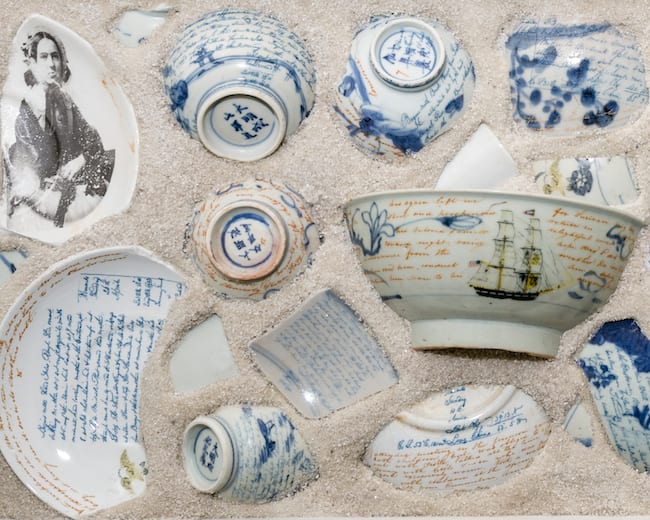For her exhibit Strong Breezes and Passing Clouds at the Cape Ann Museum, MA., Hawaii-based artist Diane KW (Diane Chen) revisits her nautical theme of transferring images from historic documents to ceramic plates and shards that were salvaged from old shipwrecks. You can read CFile’s earlier coverage of Diane’s work (including her experiments with spam e-mails) here and view work by Diane KW for sale at the CFile Shop here.

Strong Breezes and Passing Clouds isn’t a typical art exhibition. Diane installed the series in the “functional spaces” of the museum, the coatroom vestibule and the restrooms. The sets are comprised of ceramic shards from shipwrecks dating from 1620 to 1850, which the museum states occurred in the South China Sea, the Pacific Ocean and the Atlantic Ocean. The shards were donated by marine archeologists and antique collectors. The artist commented regarding the exhibit’s location that, “In an art museum, art should be everywhere.”

There’s a story with the exhibit as well. Diane searched the Museum’s archives and found a pair of journals from 1838. These journals are from Edward Babson, a captain aboard the Cadet and his wife Amanda Babson, who was writing in Gloucester. Portions of these journals were applied to the ceramic shards. The husband and wife were separated while Edward was at sea and so Diane paired entries which were written on the same days. The journal entries are peppered with historic accounts of lost or missing ships at sea.

An unsettling, almost creepy, effect is achieved as we consider the journals’ contents. Babson was never shipwrecked but that thought is never far from his mind during his travels. That fear factors greatly into his entries from the trip. It would be easy to write his concerns off as simple anxiety, but Diane’s choice to print these on shards from actual shipwrecks confirms his fears— he could have been one of these wrecks. It’s a clever, devious comment for Diane KW to make and it’s a good thing for Babson’s peace of mind that he’s not around to see these today. As a fan of horror, I love how the story plays out on quiet, elegant blue and white ceramic objects. The narrative subverts the expectations created by the medium it’s printed on and I hope it traps visitors who happen to glance at the exhibit in passing as they leave the bathroom.

This isn’t to say that suspense is Diane’s singular aim with this work. Since she was working with people’s journals, she was able to highlight what was happening to her subjects in their quieter moments. I especially like Edward Babson’s experiments with art. Some of his sketches of birds or passing ships adorn works in the exhibition. A plate Diane made for the exhibit also shows Babson practicing his penmanship while his vessel was becalmed. The artist states that he would write “calm” or “dead calm” over and over again, trying to perfect his handwriting.
Diane KW became an artist following a career as a neurologist, epidemiologist and researcher in the United States and Switzerland. Much of her work we’ve shown on CFile deals with similar collage work on ceramic shards, but she also creates hand-carved vessels, which you can see on her website linked above. She’s exhibited at the Honolulu Museum of Art, the Nanchong University Ceramic Museum in China and the Groninger Museum in the Netherlands.

In addition to the installations in the Museum’s functional spaces, Diane also has an exhibit of six Chinese export plates from 1735 to 1750 which continues the story of the Babsons. Images of these plates and their descriptions by the artist follow below.
Bill Rodgers is a Contributing Editor at CFile.
Above images: Installation views of Strong Breezes and Passing Clouds by Diane KW, 2014, at the Cape Ann Museum. All installation photographs by Judith Monteferrante, courtesy of the artist.
Any thoughts about this post? Share yours in the comment box below.

Antique Chinese plates with digital transfers by Diane KW, 2014.


Diane KW, Birds of a Feather, 2014. The plate is decorated with a birds in the garden and around the border of the plate. The images are from a drawing done by Edward Babson during one of his voyages.


Diane KW, Dead Calm, 2014. Not only was bad weather to be avoided, but a dead calm was equally undesirable for a merchant ship at sea. Edward Babson’s calligraphy embellishes this plate — when there was no wind he would pen “calm,” or “dead calm” in large lettering in his logbook, using the free time to perfect his penmanship.


Diane KW, Ship Ahoy, 2014. Ceramic transfers of the Brig Cadet drawn by Edward Babson decorate the border of this plate. A page from the Cadet account ledger is added to the center.


Diane KW, Medallion Plate, 2014. Photographs of Edward and Amanda Babson and their five children are arranged as medallions on the plate border, much in the way a family crest might be added to a plate of this period.


Diane KW, Disbursed Disbursements, 2014. One of Edward Babson’s disbursement sheets has been dispersed across the plate.


Diane KW, Wheel of Fortune, 2014. Comments about the weather on several journeys of the cadet are arranged as a wheel of fortune game. The weather in these journeys was unpredictable, thus sailing the seas in the mid-19th century was a bit like “spinning the wheel.”

Diane KW. Photograph by Mike Springer.

Intriquing & interesting ! Very original idea!
Wow!!!!